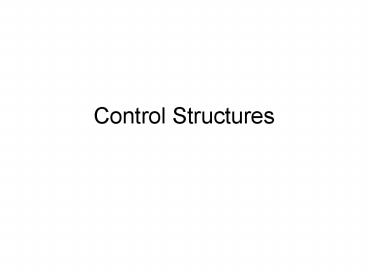Control Structures - PowerPoint PPT Presentation
1 / 17
Title:
Control Structures
Description:
Reads a line and throws it away, does NOT assign to $_ do ... When modified by while or until, run through block once before checking condition ... – PowerPoint PPT presentation
Number of Views:48
Avg rating:3.0/5.0
Title: Control Structures
1
Control Structures
2
if-elsif-else
- semantically the same as C/C
- syntactically, slightly different.
- if (a gt 0)
- print "\a is positive\n"
- elsif (a 0)
- print "\a equals 0\n"
- else
- print "\a is negative\n"
- brackets are required!
3
unless
- another way of writing if (!)
- analogous to English meaning of "unless"
- unless (EXPR) BLOCK
- "do BLOCK unless EXPR is true"
- "do BLOCK if EXPR is false"
- can use elsif and else with unless as well
4
while/until loops
- while (EXPR) BLOCK
- "While EXPR is true, do BLOCK"
- until (EXPR) BLOCK
- "Until EXPR is true, do BLOCK"
- "While EXPR is false, do BLOCK"
- another way of saying while (!)
- again, brackets are required
5
while magic
- If and only if the only thing within the
condition of a while loop is the readline
operatorwhile (ltfhgt) - perl automatically translates this towhile
(defined(_ ltfhgt)) - _ holds the line that was just read.
- When ltfhgt returns undef (ie, file completely
read), loop terminates. - This does NOT happen anywhere else!ltfhgt
- Reads a line and throws it away, does NOT assign
to _
6
do
- Execute all statements in following block, and
return value of last statement executed - When modified by while or until, run through
block once before checking condition do
i while (i lt 10)
7
for loops
- Perl has 2 styles of for.
- First kind is virtually identical to C/C
- for (INIT TEST INCRMENT)
- for (my i 0 i lt 10 i) print "\i
i\n" - yes, the brackets are required.
8
foreach loops
- Second kind of for loop in Perl
- no equivalent in core C/C language
- foreach VAR (LIST)
- each member of LIST is assigned to VAR, and the
loop body executed - my sumforeach my value (_at_nums) sum
value
9
More About for/foreach
- for and foreach are synonyms
- Anywhere you see "for" you can replace it with
"foreach" and viceversa - Without changing ANYTHING ELSE
- they can be used interchangeably.
- usually easier to read if conventions followed
- for (my i 0 ilt10 i)
- foreach my elem (_at_array)
- but this is just as syntactically valid
- foreach (my i 0 ilt10 i)
- for my elem (_at_array)
10
foreach triviata
- foreach VAR (LIST)
- while iterating through list, VAR becomes an
alias to each member of LIST - Changes to VAR within the loop affect LIST
- if VAR omitted, _ used instead
- it too is an alias
- _at_array (1, 2, 3, 4, 5)foreach (_at_array) _
2 - _at_array now ? (2, 4, 6, 8, 10)
11
foreach loop caveat
- my num 'alpha'for num (0..5) print
"num num\n" - Upon conclusion of the loop, num goes back to
'alpha'! - The for loop creates its own lexical variable,
even though you didn't specifyfor my num (0..5)
- For this reason, it is always preferred to
explicitly declare the variable lexical to the
loop, to avoid the possible confusion.
12
Best Practice
- There is rarely any need to use C-style for
loops in Perl - If you want to iterate over a count value
- foreach my count (0..total)
- foreach my i (0..array)
- Only time you need a C-style for loop is to
increment by something other than 1 - for (my v0 v lt tot i3)
13
foreach (ltfhgt) vs while (ltfhgt)
- Both constructs appear to do the same thing.
- Assign each line of fh to _, execute loop body
- The difference is internal
- foreach takes a LIST
- evaluates ltfhgt in list context
- while's condition is defined (_ ltfhgt)
- evaluates ltfhgt in scalar context
- foreach will read the entire file into memory at
once - each element of resulting list is then assigned
to _ - while will read the file line by line, discarding
each line after it's read - FAR more efficient. Always use while (ltfhgt)
14
Reading it in English
- Perl has a cute little feature that makes simple
loop constructs more readable - If your if, unless, while, until, or foreach
block contains only a single statement, you can
put the condition at the end of the statement - if (a gt 10) print "\a is a\n"
- print "\a is a\n" if a gt 10
- Using this modifier method, brackets and
parentheses are unneeded - This is syntactic sugar whichever looks and
feels right to you is the way to go.
15
Loop Control next, last, redo
- last ? exit innermost loop
- equivalent of C break
- next ? begin next iteration of innermost loop
- (mostly) equivalent of C continue
- redo ? restart the current loop, without
evaluating conditional - no real equivalent in C
- Note that Perl does not consider do to be a
looping block. Hence, you cannot use these
keywords in a do block (even if its modified by
while)
16
Breaking Out of More Loops
- next, last, redo operate on innermost loop
- Labels are needed to break out of nesting loops
- TOP while (i lt 10)MIDDLE while (j gt 20)
BOTTOM for (_at_array) if (_ i
j) last TOP
if (i 3 gt _) next
MIDDLE
j-- i
17
goto
- yes, it exists.
- No, dont use it.






























